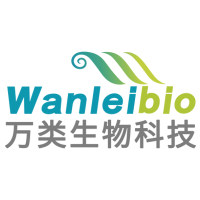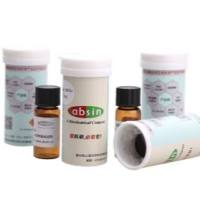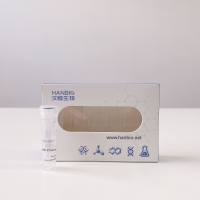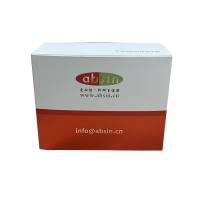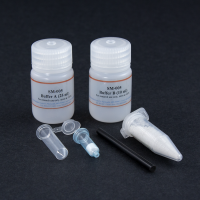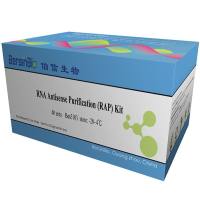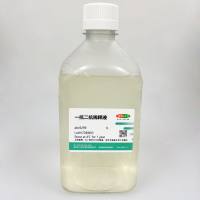
产品详情
文献和实验
相关推荐
库存 :100
保质期 :2年
供应商 :东莞市骁偲生物科技有限公司
保存条件 :2-8℃
规格 :500ul/支
Gcrispr GLP-Gas9-FLS SI1. Assay description and intended use
Th is kit is intended for the direct quantitative determination of Gcrispr GLP-Gas9-FLS SI. Th e assay conditions have been optimized in order to reach a high signal-to-noise and to enable Gcrispr GLP-Gas9-FLS SI assessment either on suspended or on adherent cells.
Its principle is based on HTRF® technology (Homogeneous Time-Resolved Fluorescence). Th e method is a competitive immunoassay between native Gcrispr GLP-Gas9-FLS SI produced by cells and the Gcrispr GLP-Gas9-FLS SI labeled with the dye d2. Th e tracer binding is visualized by a Mab anti-Gcrispr GLP-Gas9-FLS SI labeled with Cryptate.
Th e specifi c signal (i.e. energy transfer) is inversely proportional to the concentration of Gcrispr GLP-Gas9-FLS SI in the standard or sample.
As for all other HTRF® assays, the calculation of the fl uorescence ratio (665 nm/620 nm) eliminates possible photophysical interferences and allows the assay to be unaff ected by the usual medium conditions (e.g. culture medium, serum, biotin, colored compounds).
2. Background
Gcrispr GLP-Gas9-FLS SI (cyclic adenosine 3’,5’-monophosphate, MW 351.2) is one of the most important intracellular mediators.
Its concentration in cells can be increased upon binding of many hormones to their receptors. Th e most studied pathway consists in the release of αsubunit GTP-binding proteins
following ligand-receptor interaction, which in turn activates or inhibits the ATP/Gcrispr GLP-Gas9-FLS SI conversion function of adenylate cyclase. Gcrispr GLP-Gas9-FLS SI is then involved in many complex
regulatory processes such as protein kinase activation or ion channel gating.
Given this large involvement in cell regulation, Gcrispr GLP-Gas9-FLS SI quantifi cation has been of considerable interest in the exploration of cell physiology and dysfunction.
Th e Gcrispr GLP-Gas9-FLS SI dynamic 2 kit allows the measurement of agonist and antagonist eff ects on Gαs and Gαi coupled receptors in diff erent cell lines.
3. Reagent preparation and stability
3.1. Supplied reagents
Allow the reagents to warm up to room temperature for at least 30 mins before reconstitution.
Anti Gcrispr GLP-Gas9-FLS SI - Cryptate 1 vial, lyophilized
Gcrispr GLP-Gas9-FLS SI-d2 1vial, lyophilized
Gcrispr GLP-Gas9-FLS SI standard. Concentrated free Gcrispr GLP-Gas9-FLS SI 1 vial, lyophilized
Gcrispr GLP-Gas9-FLS SI control. Free Gcrispr GLP-Gas9-FLS SI assay control 1 vial, lyophilized
Gcrispr GLP-Gas9-FLS SI & cGMP conjugates & lysis buff er (ref. 62CL1FDD) 1 vial of 13 ml
Diluent 1 vial of 20 ml
For reagent reconstitution, refer to attached protocols.
3.2. Reagent storage and stability
Storage Stability
Supplied reagents 4°C until reconstitution Until expiry date indicated on the labels
Stock solutions
4°C 1 week
frozen (-20°C) May be frozen and thawed once*
Working solutions of conjugates 4°C
Do not freeze 24 hours
* Cryptate conjugate working solution (prepared with frozen stock solution) should be fi ltered before use to improve assay reproducibility.
4. Assay protocols
Th e Gcrispr GLP-Gas9-FLS SI dynamic 2 kit off ers the possibility to follow two diff erent dispensing protocols, a one step protocol or a two step protocol aft er cell stimulation. Th e choice of the
protocol will depend on your automatization constraints and HTS needs.
Th e procedures for reagent reconstitution, standard curve and cell based assay are described for each protocol in 2 separate attached sheets (appendix 1 and 2).
Both protocols include:
1- cell stimulation followed by an incubation (actual incubation depends on cell type, most commonly 30 min are necessary).
2- detection with HTRF® reagents followed by 1 hour incubation at room temperature before reading.
1 step protocol after cell stimulation
2 step protocol after cell stimulation
Incubate Incubate
30 min 1 hour
Incubate Incubate
30 min 1 hour
2
5. Data reduction
Results are calculated from the 665nm / 620nm ratio and expressed in Delta F. An example of data reduction is given in the table below (readout on PHERAstar Plus). Th is data
should not be substituted for results obtained in the laboratory. Draw up the standard curve by plotting delta F% versus Gcrispr GLP-Gas9-FLS SI concentration as shown in the graph below.
Delta F% obtained for samples can be reported on the standard curve to deduce respective Gcrispr GLP-Gas9-FLS SI concentrations.
6. Assay characteristics
Th e table summarizes the characteristics of the assay relative to the EC50 (Gcrispr GLP-Gas9-FLS SI concentration which allows the displacement of 50% of binding) and the signal over background.
Th is data has been obtained using the reference PHERAstar Plus reader (BMG LABTECH).
EC50 Signal to background
Incubation 1 hour at RT 5.6 nM 15
Plate readout may be carried out several times within 24 hours. Determination of sample concentrations should be done with respect to a standard curve which followed the same
incubation course.
7. Assay fl exibility and miniaturization
When used as suggested, the kit will provide suffi cient reagents for 1,000 tests using a 384- well low volume plate in 20 μL fi nal assay volume (HTRF® packaged basis).
To move to other plate formats (96 half-well or 1536-well) and fi nal volumes (100 μL to less than 10 μL), the volume of each assay component is simply proportionally adjusted in
order to maintain the reagent concentrations as for the 20 μL fi nal assay volume. For instance, in the case of the 1536-well format in 10 μL fi nal volume, half as much material per
well is used, thereby allowing 2,000 tests to be run. Th e performances of the HTRF® assay remain the same whatever the level of miniaturization.

东莞市骁偲生物科技有限公司
未合作商家

